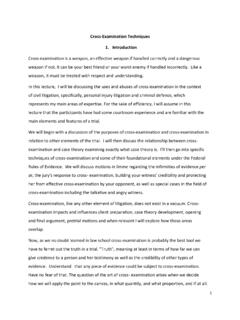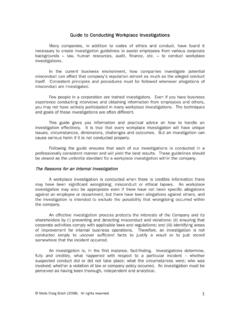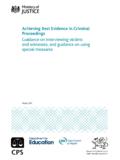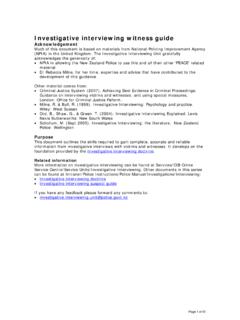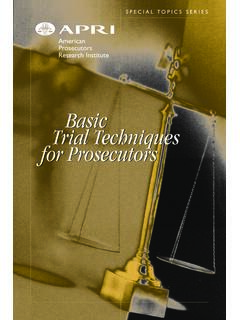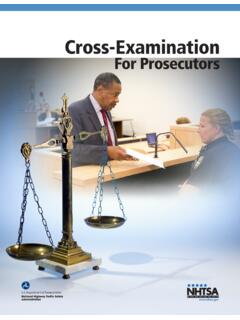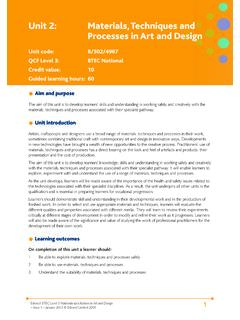Transcription of Asylum interviews - GOV.UK
1 Page 1 of 67 Published for Home Office staff on 03 June 2021 Asylum interviews Version Page 2 of 67 Published for Home Office staff on 03 June 2021 Contents Contents .. 2 About this guidance .. 6 Contacts .. 6 Clearance and publication .. 6 Changes from last version of this guidance .. 6 Purpose of guidance .. 8 Background .. 8 Policy objective .. 8 Asylum interviews : best interests of the child .. 9 Safeguarding .. 9 Signposting to support services .. 10 Relevant legislation .. 11 The 1951 Refugee Convention .. 11 European legislation .. 11 The Immigration Rules .. 11 Other legislation .. 12 Interview arrangements .. 13 Personal conduct .. 13 Invitation to interview .. 13 Appropriateness of interviewing by video conference (VC) .. 14 When a child turns 18 before the substantive interview.
2 15 Children and families .. 15 Childcare during Asylum interviews .. 16 Non-suspensive appeal (NSA) cases .. 16 Non-attendance .. 16 Non-attendance due to illness .. 17 Non-attendance for other reasons .. 19 Treat the claim as withdrawn because of non-attendance .. 19 Choice of language .. 19 Requests for a male or female interviewer or interpreter .. 19 Pregnancy and maternity .. 20 Friends, companions or supporters .. 20 Religious festivals .. 21 Health, safety and risk assessments .. 21 Page 3 of 67 Published for Home Office staff on 03 June 2021 interviews in prison .. 21 Recording interviews in prison .. 22 Detained Asylum Casework .. 22 Video conferencing (VC) .. 22 Remote interviews and interpreters .. 23 Submission of documents in VC interviews .. 24 Safeguarding in VC int erviews.
3 24 Interview recording policy .. 26 Transcript of interviews .. 26 Audio recording interviews .. 26 Inform the claimant .. 26 Exemptions to audio recording interviews .. 26 Refusal on non-compliance grounds .. 27 Failure of audio recording equipment .. 27 Provide a copy of the audio recording .. 28 VC interviews .. 28 Face to face interviews .. 28 Other requests for interview recordings .. 28 Interview: preparation and structure .. 29 Preparing for the interview .. 29 Biometric Residence Permit .. 29 Emergency Travel Document (ETD) application .. 30 Start the interview .. 30 Verifying identity .. 31 Written statements .. 31 Documents and other evidence at interview .. 32 Overseas documents .. 32 UK 32 Breaks in the interview .. 33 Aggressive or threatening behaviour.
4 33 Family reunion .. 34 Gathering information .. 34 Investigating the Asylum claim .. 36 Principles and standards .. 36 Exploring the immigration history .. 38 Inadmissibility on safe third country grounds .. 38 Page 4 of 67 Published for Home Office staff on 03 June 2021 Section 8 of the Asylum and Immigration (Treatment of Claimants, etc) Act 2004 .. 38 Additional factors relevant to assessing credibility .. 39 Individual factors .. 39 Interviewing techniques .. 41 Open and closed questions .. 41 Summarise and signposting .. 42 Verifying witness statements and other evidence provided .. 42 Exploring sensitive topics .. 43 Level of detail .. 44 Questions about the basis of the 45 Religion or belief .. 45 Sexual orientation or gender identity .. 46 Another person s actions or circumstances.
5 48 Evidence of war crimes or other serious crimes .. 49 Victims of torture or other trauma .. 50 interviews with victims of torture or trauma .. 50 Victims of gender based persecution .. 51 Claimants with scars .. 51 Victims of modern slavery .. 52 Modern slavery: Asylum interview and National Referral Mechanism (NRM) process .. 52 Modern slavery: interview for NRM .. 52 Particular interview needs .. 54 Learning difficulty or disability .. 54 Mental illness .. 55 Considering self-harm and suicide risk .. 55 Concluding the interview .. 57 Submission of further evidence .. 57 Concluding the interview .. 57 Interview transcript .. 58 Action after the interview .. 58 Legal representatives .. 60 Checking registration .. 60 Professional conduct of legal representatives.
6 60 Interpreters .. 62 Conduct and professional standards: Home Office interpreters .. 62 Page 5 of 67 Published for Home Office staff on 03 June 2021 Interpreters attending with legal representatives .. 63 Interpreters attending without legal representatives .. 64 Interpreter disagreements .. 64 Languages at interview .. 65 Complaints .. 66 Complaints made during an interview .. 66 Complaints about an interpreter .. 66 Complaints of discrimination .. 66 Page 6 of 67 Published for Home Office staff on 03 June 2021 About this guidance This guidance tells you how to carry out effective Asylum interviews to obtain relevant information to establish, as far as possible, whether the claimant meets the requirements for an Asylum or human rights claim to succeed. It applies to any member of staff conducting a substantive Asylum interview.
7 It provides specific guidance on: interview arrangements and formalities preparing for an Asylum interview how to investigate an Asylum claim, including important principles, questioning techniques and factors that may affect an individual s ability to provide evidence This instruction must be read in alongside the main Asylum policy instructions, in particular, assessing credibility and refugee status, gender issues in the Asylum claim, gender identity issues in the Asylum claim, sexual orientation issues in the Asylum claim, disclosure and confidentiality of information in Asylum claims dependants and former dependants and in the case of children, processing children s Asylum claims. Contacts If you have any questions about the guidance and your line manager, Technical Specialist or Senior Caseworker cannot help you, or you think that the guidance has factual errors, you can email the Asylum Policy team.
8 If you notice any formatting errors in this guidance (broken links, spelling mistakes and so on), or have any comments about the layout or navigability of the guidance, you can email the Guidance Rules and Forms team. Clearance and publication Below is information on when this version of the guidance was published: version published for Home Office staff on 03 June 2021 Changes from last version of this guidance updated in line with current drafting requirements updated throughout to reflect existing operational practices, including childcare provision, interviewing a child who has recently turned 18, what action to take if someone is unwell, recording interviews , particular interview needs, and modern slavery and the National Referral Mechanism (NRM) process.
9 Additional detail provided to a number of sections to assist decision makers, including verifying identity, working with interpreters, considering overseas Page 7 of 67 Published for Home Office staff on 03 June 2021 documents, and obtaining relevant information to assist consideration of family reunion applications. expanded section on remote interviewing and updates throughout to ensure guidance applies to both remote and in-person interviews updated to include advice on inadmissibility on safe third country grounds additional detail provided on exploring the immigration history and factors relevant to assessing credibility Related content Contents Page 8 of 67 Published for Home Office staff on 03 June 2021 Purpose of guidance Background The Asylum interview is an important part of the Asylum process because it is the main opportunity for the claimant to provide relevant evidence about why they need international protection and for you, as the person conducting the interview, to help draw out and test that evidence.
10 It is important that you create an environment in which claimants feel at ease and able to disclose all relevant information to you, allowing you to fully investigate the key issues through focused, professional and sensitive questioning. This is particularly relevant as some evidence may be highly complex and emotive, relating for example to instances of persecution or serious harm, including sexual violence or torture. Such evidence is crucial to ensure that Asylum claims are properly considered, so that protection is granted to those who genuinely need it and refused to those who do not. It is also important to remember that, in some circumstances and particularly in relation to highly sensitive information, disclosure may not happen during the interview, despite the interviewer s best efforts.










